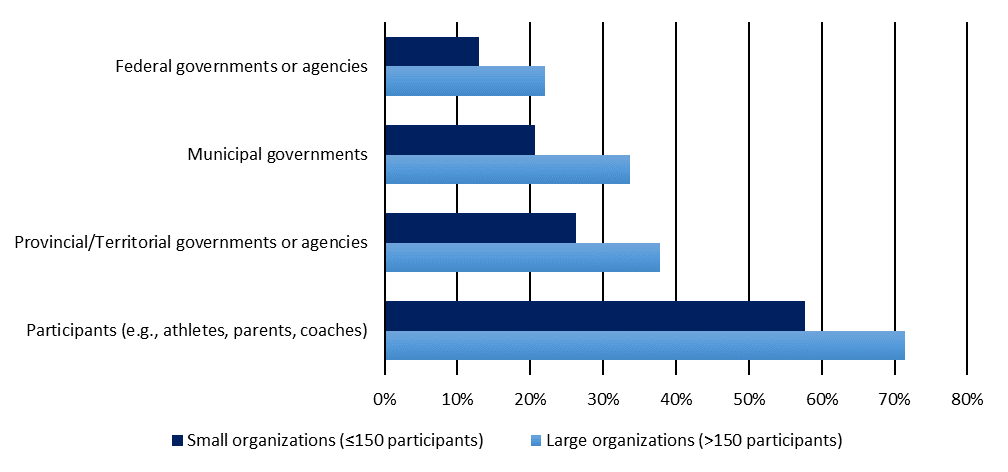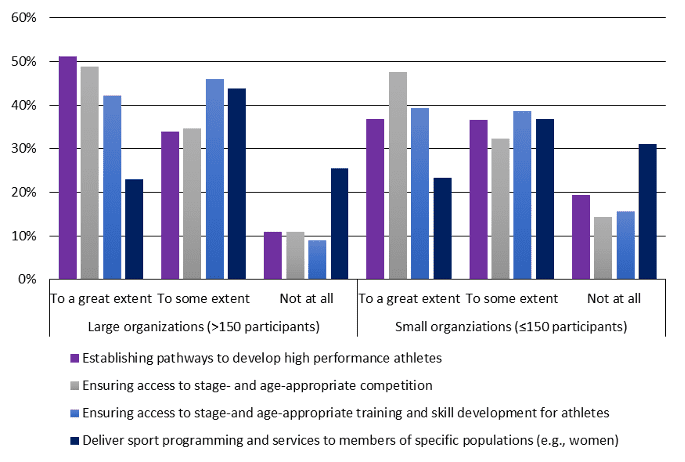
Sport participation among Canadian adults has generally remained the same at around 27%, and this percentage has shown to be lower for certain groups within the population (e.g., among older adults, and women). Recognizing the critical role that sport organizations play in facilitating physical activity and sport participation among Canadians, the Canadian Fitness and Lifestyle Research Institute (CFLRI) conducted a survey of Canadian Sport Organizations (national, provincial/territorial, and community level) with the purpose of collecting important information regarding the availability of facilities, policies, programs and other opportunities to participate in sport and physical activity. This summary will focus on the collaborations between sport organizations and other organizations for the development and delivery of sport programming. As an example, this survey asked administrators to indicate the extent to which partnerships were established for recruitment and training. Sport organizations were also asked to indicate whether they worked with different groups (such as community or municipal governments or schools) when developing new and existing sport facilities and programming. Increasing sport participation and physical activity levels among all Canadians will require increasing opportunities in support of physical activity and sport participation, and in particular, among key population groups that are known to demonstrate lower levels of participation. This summary, will highlight steps taken by sport organizations to promote equity, diversity, access and inclusion in the development of sport facilities and programming.
Working with partners for the development of new and existing facilities and programming
Sport organizations were also asked to indicate which, if any, other organizations they work with when developing new or existing facilities and programming. About three out of ten organizations said they worked with community or municipal governments/agencies for the development of new or existing facilities, whereas 22% said they worked with these organizations for the development of sport programming. Roughly one-fourth of organizations (27%) indicated that they worked with participants such as athletes, parents, coaches, officials or Board members when developing facilities whereas more than half of organizations said they worked with participants for the development of sport programming. Table 1 outlines the percentage of sport organizations that report working with various organizations when developing new or existing facilities/programming.
Table 1: Percentage of sport organizations that indicate they collaborate with other organizations for the development of facilities and sport programming
| % of organizations indicating they work with… | Facilities | Programming |
| Community or municipal governments or agencies | 31% | 22% |
| Participants (e.g., athletes, parents, coaches, officials, Board members) | 27% | 54% |
| Not-for-profit organizations (e.g., other local clubs) | 20% | 38% |
| Schools or school boards | 19% | 28% |
| Industry and business, private sector | 17% | 14% |
| Provincial/territorial governments or agencies | 17% | 29% |
| Other sport organizations | 13% | 27% |
| Federal governments or agencies | 10% | 16% |
| Other national or multi-service sport organizations | 8% | 35% |
| Indigenous partners (e.g., band councils, Aboriginal Sport Circle) | 3% | 7% |
Source: CFLRI, 2020-2021 Sport Organization survey
Region – For the most part sport organizations did not differ statistically by region when it comes to working with partners for facility and program development; a couple differences, however, were noted. Fewer organizations in Quebec said they worked with other national or multi-service sport organizations or participants (such as athletes, coaches or Board members) when developing programming. Conversely, organizations in the Atlantic region were relatively more likely compared to organizations overall to have said they worked with provincial/territorial governments when developing programming (See Figure 1).
Figure 1: Regional differences in partnerships for the development of new and existing sport programming

*Data for the North suppressed due to cell size
Source: CFLRI, 2020-2021 Sport Organization survey
Organization size – Organizations differed in which organizations they work with when developing facilities and programming. Large organizations (those with over 150 participants) were more likely than smaller organizations (those with 150 or less) to say they worked with the following organizations when developing programs:
- Federal government or agencies
- Provincial or Territorial government or agencies
- Participants (e.g., athletes, parents, coaches, officials, Board members)
- Industry and business, private sector
- Community or municipal governments or agencies (e.g., transport, planning, health).
Large organizations were also more likely than small organizations to indicate that they worked with provincial or territorial governments or agencies when developing new or existing sport facilities (See Figure 2).
Figure 2: Percentage indicating that they work with others for the development of sport programming, by organization size

Source: CFLRI, 2020-2021 Sport Organization survey
Working with partners for the development and delivery of sport programs and services
The development of quality sport programming may require support from key partners to access much needed resources. Collaborating with partners may prove to be particularly advantageous for organizations that wish to reach target populations. Sport organizations were asked to indicate to what extent partners were engaged during the planning and development of sport programming. Most organizations agreed to at least some extent that they work with partners to ensure access to stage-and age- appropriate training and skill (82%), competition (81%) and for the recruitment, training and development of athletes (79%). Interestingly, many organizations (63%) also agreed that they enlist the help of partners to deliver sport programming and services to members of priority populations. Table 2 describes the extent to which sport organizations agree that they work with partners for the delivery of sport programming.
Table 2: Ratings of agreement among sport organizations in working with partners for sport programming development and delivery
| % of sport organizations that agree they work with partners | |||
| To a great extent | To some extent | Not at all | |
| Ensuring access to stage- and age- appropriate competition | 46% | 35% | 13% |
| Establishing pathways to develop high performance athletes | 43% | 35% | 15% |
| Ensuring access to stage- and age- appropriate training and skill development for athletes | 39% | 43% | 13% |
| Recruiting, training, and developing athletes | 35% | 45% | 15% |
| Recruiting, training, and developing coaches and officials | 32% | 46% | 17% |
| Deliver sport programming and services to members of specific populations | 23% | 39% | 27% |
| Recruiting, training and developing volunteers | 13% | 49% | 29% |
| Recruiting, training and developing of Board members | 11% | 43% | 37% |
Source: CFLRI, 2020-2021 Sport Organization survey
Region – There were no regional differences with respect to sport organizations’ working with partners for the development and delivery of sport programming and services.
Organization size – There were some notable differences between large and small sport organizations in reporting they work with partners when developing their sport programs. Large organizations (those with over 150 participants) were more likely than small organizations (with 150 participants or less) to agree to a great extent that they worked with partners to establish pathways to develop high performance athletes and for the recruitment, training and development of coaches and officials. Conversely, a greater proportion of small organizations indicated that they did not work with partners at all when recruiting, training and developing Board members compared to large organizations (See Figures 3a & b).
Figure 3a: Percentage of organizations indicating they work with partners for the development and delivery of sport programs and services, by organization size

Source: CFLRI, 2020-2021 Sport Organization survey
Figure 3b: Percentage of organizations indicating they work with partners for the development and delivery of sport programs and services, by organization size

Source: CFLRI, 2020-2021 Sport Organization survey
Production of this summary has been made possible through a financial contribution from the Government of Canada. The views expressed herein do not necessarily represent their views.


